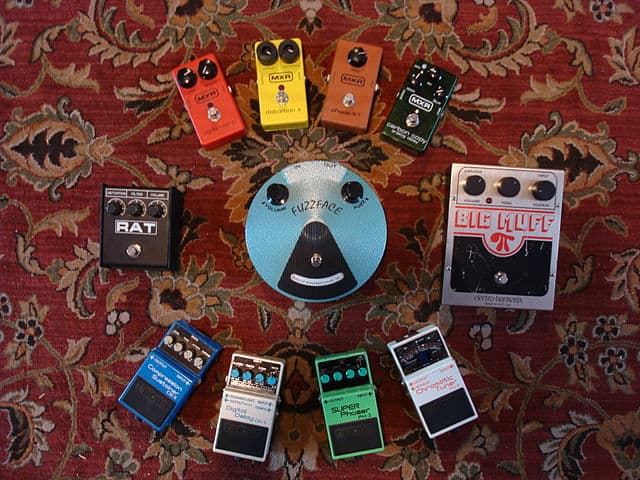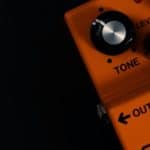Guitar pedals are the core of many players’ rigs.
To many, they are as crucial as their guitar, perhaps even more than their amps.
So, when something takes such a central position, it’s only a matter of time until discussions about its details arise.
One of the most common arguments around pedal heads is whether digital pedals can ever be as good as analog ones.
But to be able to partake in such dialectic, it’s wise to first be able to distinguish between both kinds of pedals.
So, how do you know if a guitar pedal is digital or analog?
The easiest way of knowing if a guitar pedal is digital or analog is by looking it up online. However, if you prefer a more hands-on approach or don’t have internet access, measuring its current draw is usually a good indicator with digital pedals being way more power hungry than analog units.
In this article, I will dive deep into all the small details that might help you determine if a particular pedal is analog or digital.
After leaving this page you will be equipped with better knowledge about how pedals work, know some tricks to determine the way they operate, and have a formed opinion about if you should worry about this or not.
Are you ready to get started?
Let’s go!
5 ways of knowing if a pedal is digital or analog
Sadly there’s not a particular way of determining if a pedal is digital or analog.
They don’t have a certain smell or taste that gives them away, don’t even bother with it.
So, before you start chewing on your pedalboard, here are 5 ways of finding out if a pedal is digital or analog:
1. Look it up on Google
Let’s be honest, you probably have a phone with access to the internet in your pocket.
A quick Google search might provide you with all the answers you are looking for, as with anything.
However, if you are looking for methods that don’t rely on the collective knowledge of players around the world, and you want to fend for yourself, keep on reading.
2. Multi-effects are usually digital
Since it would be hard and costly to cram a multi-effects unit with all of the different pieces of hardware you would need to replicate most analog effects, it’s safe to assume that almost all multi-effects are digital.
3. Certain effects are most commonly digital or analog
Most reverb pedals are digital since analog delay usually requires actual springs or metal plates to be produced.
Delays and modulations can be tricky since you might find them of both types.
Overdrives, distortions, fuzzes, and compressors are probably most likely analog, however, with new tech coming out every year, you should take this with a grain of salt.
There are, of course, tons of these pedal types that deviate from the lax norm I just laid out.
4. Open it up and take a look
If you know a bit about electronics, perhaps taking a closer look into the circuitry inside the pedal will be a great alternative for you.
For digital pedals, you will likely be searching for chips with many tiny legs on the PCB.
5. Check the pedal’s current draw
Finally, a rather reliable way of determining if a pedal is analog or digital is by measuring its current draw.
A good rule of thumb would be that if it draws from 5 to 30 mA it’s likely to be analog, whereas when things get close to 100 mA, our suspicions should gravitate towards digital.
However, this is not fail-proof, and many players point out that led lights and certain technical features of some analog overdrive pedals might lead to a higher power draw making them clock closer to digital ones.
What’s the difference between an analog and a digital pedal?
The main difference between analog and digital pedals is that analog pedals work by passing the audio signal through circuitry comprised of electrical components, while digital ones rely on computerizing the signal, processing it, and returning it to its original form.
And that conversion of the original signal is what many more traditional players have a problem with.
You see when you work with analog components, the audio signal processed and outputted is at its full resolution, just as how it was produced, but now modified by the effect.
When things get digital, the effect’s processor needs to convert the electrical signal into ones and zeros so it can interpret it.
The conversion of an electric signal into digital is always a lossy process since you can never represent all of the original info as it exists physically because of mathematical and processing limitations.
But without getting too nerdy and technical, let’s make an analogy.
Think of a picture you take with your phone. It is a representation of an image you have also seen with your eyes, and that exists in reality.
However, the phone has to make some compromises to capture it. For instance, if you zoom in on the digital image enough you will end up finding out that it’s made out of millions of pixels that each represent a single color.
Things in real life don’t work like that. You could actually “zoom” into a real object almost infinitely until you see its atoms, and then some more.
Digital audio signals can be thought of as pixelated versions of their original electric counterparts.
Are analog pedals better?
Analog pedals are not necessarily better, and this affirmation will only get stronger with time as digital technology improves.
Perhaps, back in the day, digital gear was just a gimmick or the cheaper alternative to the real thing, but with modern advancements, I would argue it’s almost impossible to distinguish digital tones from “real” ones, at least from high-end gear.
Are all modern pedals digital?
No, not all modern guitar pedals are digital if by “modern” you mean manufactured these last years.
There are still a lot of pedal makers that prefer the old ways and embrace circuitry and actual electronic components.
Although, since digital alternatives get cheaper, better sounding, and easier to develop day by day, it’s only natural that a lot of new gear is digital nowadays.
Should you worry about what type your pedal is?
You shouldn’t worry about if your pedals are digital or analog. It’s a silly thing to do.
The only things you should worry about in your gear are if it sounds good to you, if it’s reliable, and if it fits within your music properly.
The moral discussions that go nowhere about how analog units sound warmer or better are now quite old, and most touring artists prefer to rely on easily available, convenient, and replaceable digital units.
But don’t get me wrong, there’s plenty of room and demand for analog music gear, and I even love it. However, it has become more of an aspirational thing or a luxury nowadays since it’s more expensive and not as convenient.

Hello there, my name is Ramiro and I’ve been playing guitar for almost 20 years. I’m obsessed with everything gear-related and I thought it might be worth sharing it. From guitars, pedals, amps, and synths to studio gear and production tips, I hope you find what I post here useful, and I’ll try my best to keep it entertaining also.





